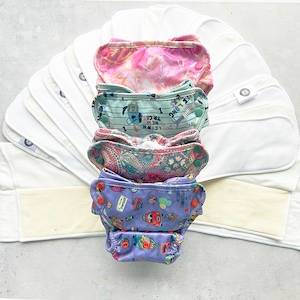
An ardent Bumpadum user, Dr. Betsy Shalom addresses the concerns related to Diaper rashes in this guest blog post.
Diaper rash is the most common type of skin eruption encountered in infants and toddlers and is truly agonizing, both for the parents and the baby. But why does it occur? Are there ways to prevent them from happening? A cloth diapering mom myself, this blog post is my attempt to clear doubts regarding diaper rashes and ways to prevent them from occurring.
What are rashes and why do they occur?
More often than not, a host of factors contribute to diaper rash. Excessive moisture, skin friction, altered skin pH (a measure of skin alkalinity or acidity) are the usual suspects which can disrupt the primary skin barrier resulting in what we visibly perceive as rashes.
Wetness: The fact that diapers by design are snug and allow very little air to pass through, babies’ faeces and excessive urine tends to leave the skin feeling wet. When left for extended periods of time, the naturally occurring enzymes in the urine and faeces alter the skin’s pH, making the situation even worse. While our skin is the first line of defense against bacteria and other disease causing agents, prolonged wetness and altered pH tends to disrupt this, leading to a malfunction.
Detergent buildup: Detergent residues, along with the ammonia (from the urine) that lingers on in cloth diapers could result in the eruption of rashes. And, this, usually is the result of not following the recommended wash and care routine. Detergents may result in rashes due to two reasons—detergent buildup in the diapers or babies being sensitive to a particular type of detergent. The former is far more common than the latter and it is essential to differentiate between the both as solutions are different as well.
There may be other reasons which might be causing and aggravating the rash. Alcohol based wet wipes could give rise to allergies in some children, while some may be extremely sensitive to certain types of fabrics such as micro-suede or bamboo. Few others might develop rashes when they are introduced to solids, especially foods that are slightly acidic in nature. You may also notice that certain antibiotics tend to worsen an existing rash, and this is mainly because the antibiotics alter the gut bacteria resulting in a pronouncement of the rashes. Therefore, it is very important to notice the signs and pick a solution that is most appropriate.
How to keep rashes away
Two seemingly simple, but extremely vital things can go a long way in keeping your baby’s bottom rash free—One, maintaining good hygiene and two, good wash routine. There are no short-cuts and these have to be followed religiously to ensure there are no rash episodes troubling the baby.

- Diapers need to be changed as soon as they are pooped in.
- Plain warm water and a soft cotton cloth are usually sufficient to wipe baby’s bottoms.
- Clean the baby thoroughly every time. Don't just clean the areas around the genitals and anus, but pay equal attention to the thigh creases, the lower abdomen and buttocks.
- Use fragrance free wipes and soaps as much as possible
- Stick to coconut oil if you are faced with rashes. Avoid diaper rash creams and ointments while using cloth diapers.
- If the need to use diaper rash creams arises, make sure to use a fleece liner to prevent the cream from coming into contact with the diaper as it could affect its absorbency.
- Do not use any steroid /anti-inflammatory/ antifungal / antibacterial/ anti microbial or anti whatever based creams. It does more damage than good.
- Using baby powder/talcum powder is not advisable as well.
- Apart from this, giving sufficient diaper free time is advisable as this helps aerate the area better.

- Wash and care routine should be strictly as per recommendations.
- The minute you suspect detergent or pee build up, give your diapers a thorough hot water wash
- If the rashes appear generalized and not specific to a particular spot, it could be because of detergent sensitivity. In that case, try out options and stick to one that works best.
- Detergents with fragrances, colours and additives are best avoided. So are liquid detergents as they tend to contain softeners and enzymes.
- Do not soak cloth diapers in anti-septic solution.
Disposable diapers have an absorbent gel core which absorbs up to 80 times its weight in water. Logically it should reduce factors that increase the risk of diaper rash. But it doesn't do that and scientific, population based studies have shown no added benefit of disposable diapers over cloth diapers. So my advice would be to stick to natural fibers and skin friendly synthetic fibers as far as possible.
Mild to moderate rashes usually resolve in two to three days. Severe diaper rash and infections are beyond the scope of this discussion. In such situations it is advisable to consult a dermatologist (and not a pediatrician as they will not be as equipped to treat severe a skin problems as a dermatologist would be).
Despite all this, I would like to conclude with a reassuring advice--Babies are fighters and parents tends to get more distressed than them. It is perfectly normal to feel that way, but fret not. Parenting is a dynamic process. Stay calm and allow yourselves a few mistakes so that you rectify as you go.
So, when things go wrong in your cloth diapering journey, just breathe and find out what is wrong. Seek help and make the necessary changes.
Happy cloth diapering!




